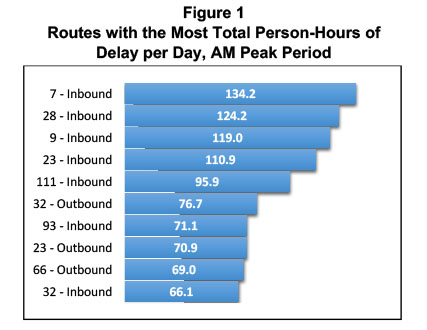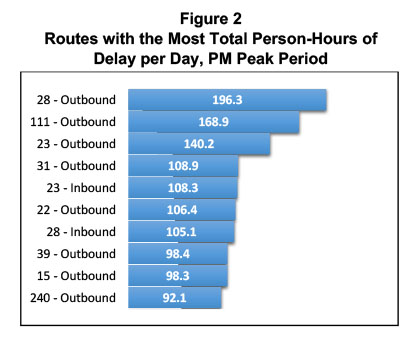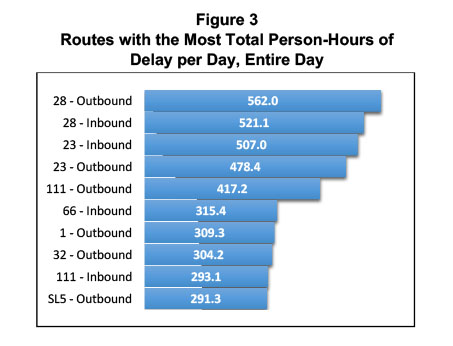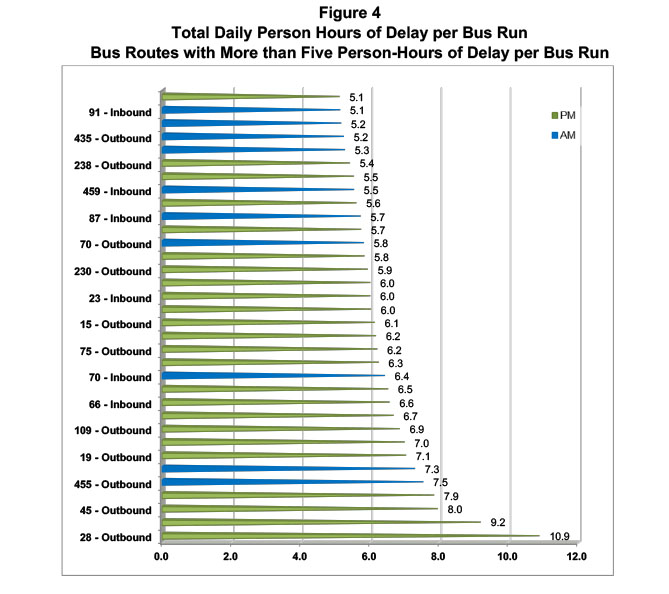
Technical Memorandum
DATE: December 21, 2017
TO: CMP Committee
FROM: Ryan Hicks, CMP Manager
RE: Fall 2016 Monitoring of MBTA Bus Performance Measures
The purpose of this memorandum is to identify congested or inefficiently operated locations within the Massachusetts Bay Transportation Authority (MBTA) bus network. The Boston Region Metropolitan Planning Organization (MPO) staff performed this specific task in response to a verbal recommendation at the MPO’s Federal Recertification Review in 2014. The recommendation—made by the Federal Transit Administration (FTA)—was that MPOs, in general, should incorporate transit performance measures into their congestion management processes (CMP).
Congestion monitoring is performed though a CMP—a federally mandated program that requires all MPOs to review alternatives to expand roadway capacity to relieve congestion. The CMP identify and document congested locations in the transportation network. Once staff discerns congested locations, the CMP then recommends low-cost non-capital strategies for implementation. The congestion management process is multi-modal; it monitors roadways, transit, high-occupancy-vehicle (HOV) lanes, and bicycle/pedestrian and park and ride facilities. MPO staff gathers data about these facilities, and employs performance measures to gauge the transportation network’s efficiency. The collected data could be used to inform planners and engineers as they make decisions about congestion-mitigation strategies. This task relates directly to the capacity management/mobility and preservation goals stated in the Boston Region MPO’s Long- Range Transportation Planning (LRTP).
The MBTA system includes a total of 9 heavy rail rapid transit lines and light rail lines, 13 commuter rail lines, and 3 ferry lines. The CMP last monitored the MBTA transit system in 2013, using two performance measures—on-time performance and load factor. However, this study focused initially on buses because the MBTA bus system has the newest and most reliable automatic vehicle location (AVL) data available. Thus, staff analyzed only the 171 (340 bi-directional) bus routes, which include five Silver Line bus rapid transit routes, three crosstown routes and 23 express bus routes. For this analysis, staff used the following three factors:
Data for this project came from multiple sources including existing MBTA data (see Table 1). For the purpose of this analysis, staff collected data from September, October, and November 2016; from Monday through Friday; with an AM peak period of between 7:00 AM and 9:00 AM, and a PM peak period of between 4:00 PM and 6:30 PM. The major data sources used for this project are as follows:
In this study, staff used eight performance measures altogether to gauge congestion on the bus network. In order to calculate the performance measures, staff collected MBTA timepoint data. Table 1 lists the performance measures that were used for this study along with the data components that were needed to compute each performance measure.
Table 1
Performance Measures and Data Sources
Performance Measure |
Data Needed/Source |
On-time performance |
Timepoints; number of stops where buses arrive late |
Transit time index |
Average bus run time; scheduled bus run time |
Person hours of delay |
Bus run delay; average number of people on bus run |
Bus run delay |
Average bus run time; scheduled bus run time; departure delay time |
Passenger crowding/ load factor |
Maximum number of people on bus run; number of bus seats |
Pass-up standard |
Maximum number of people on bus run; number of bus seats; total number of bus runs; number of bus runs that fail pass-up standard |
Person-hours of delay per bus run |
Total person-hours of delay, total number of bus runs |
Percent of delay during peak periods |
Total person hours of delay for peak period; total person-hours of delay for the entire day |
The data provided was originally separated by bus line, bus run, and time of day (AM peak, PM peak, or off-peak period). Staff executed an analysis using RStudio1 to transform data that was collected from the MBTA into data that is averaged for each bus route for each time period. The criteria listed in Table 1 are used as the attributes and are sorted by bus route for each time period. A table that has the above attributes for every bus route is displayed in Appendix B. In addition, this table was joined to a bus network shapefile, which was used to create the maps in Appendix A.
To monitor performance on a transportation network properly, it is important to measure congestion in each of the following four categories: duration, extent, intensity, and reliability. Each performance measure is designed to measure one of these categories, descriptions of which are listed below.
Duration performance measures gauge how long a bus route is congested during the peak period, or the length of delay that occurs as a result of congestion.
Extent performance measures estimate the number of passengers or buses that are affected by congestion, and the geographic distribution of congestion.
Intensity performance measures show the severity of congestion and typically differentiate between the levels of congestion on different bus lines.
Reliability is the variation in the first three performance measure categories between peak-period and off-peak-period time. Reliability performance measures indicate how a trip may be affected by nonrecurring congestion as well as by recurring congestion.
Historically, the MBTA’s on-time performance measure has been used for CMP monitoring; and will be reported according to the MBTA’s definition of reliability. Data from this performance measure is available on the MBTA Back on Track dashboard. Bus service is measured at both terminuses of the route and at midpoints.
The peak periods are slightly different2 from those used in the other performance measures. For the purpose of this study, the CMP threshold of 60 percent of timepoints that experience on-time performance is used as a parameter to determine on-time performance.
Transit time index compares the average travel time of buses through a route during a given time period with the scheduled travel time during that time period. This measure can be used to calculate delay along a bus route. Routes that have a transit time index of more than 1.3 are considered to be congested. This data was provided by the MBTA, via the crossing summary/timepoint data. Unlike person-hours of delay, this measure does not factor in late departure time, thus making it the best measure to determine if there is a roadway congestion problem along a bus line.
Transit Time Index = Average Travel Time / Scheduled Travel Time
Transit Time Index Threshold = Greater than 1.3
This performance measure combines ridership numbers with the travel time delay of the buses. Late origin-departure is also included in determining person-hours of delay (late departure time is capped at 15 minutes). The delay for each run can be multiplied by the average ridership for that run. The hours of delay can be calculated for the peak period, entire day, or entire year.
Bus Run Delay = (Actual Travel Time for Bus Run + Departure Delay
Time) - Scheduled Travel Time
Person Hours of Delay per Run = Bus Run Delay * Average Number of
People on Bus Run
Passenger crowding is measured as the ratio of the number of passengers on a vehicle at the maximum load point to the number of seats on the vehicle. For CMP purposes, MBTA thresholds for passenger crowding are used in this performance measure. If the ratio of passengers to seats is more than 1.4 at any point during a specific trip, then the route is considered to be crowded. Data will be available from either APC or ridecheck data.
Passenger Crowding Threshold = Maximum Load of
More than 1.40 Passengers per Seat
Pass-up standard estimates the number of trips on a bus route that leave passengers at a stop. It is assumed that if the maximum passenger load on a bus is more than 1.50 times the number of seats, then the bus is likely leaving passengers at stops because of lack of capacity.
Person-hours of delay are calculated for each peak period and for the entire service day. If more than 60 percent of the total daily person-hours of delay occur during a single peak period, then the bus route is flagged as having a high directional travel split, which means that the route has a high incidence of delay in one direction and little or no travel delay in the opposite travel direction. If delays are concentrated during certain times of day, schedule adjustments may be necessary.
Percent of Delay during Peak Periods = Total Person-Hours of Delay for
Each Peak Period / Total Person-Hours of Delay for Entire Day
Percent of Delay during Peak Periods Threshold = More than 60 Percent
during a Single Peak Period
This performance measure shows the average person-hours of delay per trip for each bus route regardless of service frequency. (Use of absolute person-hours of delay per route could overstate the impact to individual passengers on high-frequency routes.)
Person Hours of Delay per Bus Trip = Daily Total Person Delay /
Total Number of Bus Trips
Person-Hours of Delay per Bus Trip = Five Hours
Table 2 displays a systemwide overview of the MBTA bus system in terms of performance measures for transit time index, delay, passenger crowding, and the percentage of delay occurring during the peak periods.
Table 2
Systemwide Overview of the MBTA Bus System, Fall 2016
Performance Measure |
Fall 2016 Result |
AM transit time index |
1.15 |
PM transit time index |
1.16 |
AM total bus trip delay |
339.1 hours |
PM total bus trip delay |
428 hours |
Total daily bus trip delay |
1,655.5 hours |
AM load factor |
0.76 |
PM load factor |
0.75 |
Daily load factor |
0.49 |
Weekday peak period on-time performance |
55% |
Directional routes that fail pass-up standard at any time |
15 out of 340 routes |
Person-hours of delay in AM peak |
4,782 hours |
Person-hours of delay in PM Peak |
6,345.1 hours |
Total person-hours of delay per day |
23,188.7 hours |
Percentage of person-hours of delay in AM peak |
20.60% |
Percentage of person-hours of delay in PM peak |
27.40% |
AM person-hours of delay per bus trip |
2.1 hours |
PM person-hours of delay per bus trip |
2.5 hours |
Total daily person-hours of delay per bus trip |
1.7 hours |
This section analyzes performance monitoring results for individual bus routes and identifies problem areas in the bus network based on the performance measures for duration, extent, intensity, and reliability.
Table 3 shows the routes that have the highest percentage of person-hours of delay during a specific peak period. Most of the routes that are listed in this table are express bus routes.
Table 3
Percent of Delay during Designated Peak Period
Bus |
Direction |
Percentage Delay |
Time |
439 |
Outbound |
95% |
PM |
SLW |
Inbound |
85% |
PM |
57A |
Outbound |
85% |
PM |
326 |
Inbound |
84% |
AM |
352 |
Outbound |
84% |
PM |
448 |
Outbound |
83% |
PM |
325 |
Outbound |
83% |
PM |
351 |
Outbound |
82% |
AM |
7 |
Inbound |
81% |
AM |
326 |
Outbound |
81% |
PM |
Figures 1, 2 and 3 display the routes with the most total person-hours of delay for the AM peak period, PM peak period, and all day. Figure A-3 in Appendix A shows a detailed map that displays all MBTA bus routes based on amount of person-hours of delay. Most of the routes that have a large number of person hours of delay per day are among those with the greatest number of bus trips per day. With the exception of route 240 outbound in the PM peak period, every route displayed in these figures is in the top-40 group of total bus trips in the displayed peak period. Figure A-5 displays the person-hours of delay by bus route.
Figure 1
Routes with the Most Total Person-Hours of
Delay per Day, AM Peak Period

Figure 2
Routes with the Most Total Person-Hours of
Delay per Day, PM Peak Period

Figure 3
Routes with the Most Total Person-Hours of
Delay per Day, Entire Day

Figure 4
Total Daily Person Hours of Delay per Bus Run
Bus Routes with More than Five Person-Hours of Delay per Bus Run

Table 4 lists the bus routes with the highest maximum load factor in fall 2016. Bus Routes 71 and 73 both have vehicle fleets that have fewer seats than the fleets on other routes. Many of the bus routes with a very high load factor traverse the near-west portion of the MPO region.
Table 4
Bus Routes with the Highest Load Factor, Fall 2016
Route |
Direction |
Peak |
Greatest Load Factor |
73 |
Inbound |
AM |
2.23 |
73 |
Outbound |
PM |
2.19 |
71 |
Inbound |
AM |
1.94 |
70 |
Outbound |
PM |
1.85 |
71 |
Outbound |
Both |
1.81 |
57 |
Outbound |
PM |
1.79 |
57 |
Inbound |
AM |
1.69 |
87 |
Outbound |
PM |
1.59 |
101 |
Inbound |
AM |
1.56 |
65 |
Inbound |
AM |
1.54 |
Table 5 lists the bus routes that failed the pass-up standard, meaning that passengers who ride these routes during the specified period may have to wait for one or more buses to pass before one with available capacity stops. Most of the non-Silver Line routes that fail the pass-up standard are located in the near-west section of the MPO region.
Table 5
Bus Routes that Failed Pass-Up Standard, Fall 2016
Route |
Direction |
Time Period |
11 |
Inbound |
AM |
57 |
Inbound |
AM |
57 |
Outbound |
PM |
57A |
Inbound |
AM, All Day |
57A |
Outbound |
PM, All Day |
65 |
Inbound |
AM |
66 |
Inbound |
AM |
70 |
Outbound |
PM |
70A |
Outbound |
PM, All Day |
71 |
Inbound |
AM, All Day |
71 |
Outbound |
AM, PM |
73 |
Inbound |
AM, All Day |
73 |
Outbound |
PM |
87 |
Outbound |
PM |
101 |
Inbound |
AM |
Table 6 lists 14 routes that have the lowest on-time performance rate. Note that most routes failed the on-time performance standard of 60 percent. Please see Figure A-1 for a full map of the on-time performance standard.
Table 6
Bus Routes with Lowest On-Time Performance Rate, Fall 2016
Route |
On-Time Performance |
137 |
30% |
459 |
30% |
14 |
31% |
112 |
31% |
411 |
31% |
41 |
33% |
52 |
34% |
215 |
35% |
105 |
35% |
240 |
35% |
29 |
36% |
91 |
36% |
448 |
36% |
40 |
36% |
Table 7 lists the bus routes with the highest transit time index in fall 2016. Routes that have a very high transit time index probably have roadway congestion issues, which might not be directly related to MBTA operations. Figure A-2 displays the bus routes a transit time index of more than 1.30 during either of the peak periods.
Table 7
Bus Routes with Highest Transit Time Index, Fall 2016
Route |
Direction |
Transit Time Index |
Time |
109 |
Outbound |
1.56 |
PM |
326 |
Outbound |
1.54 |
PM |
72 |
Outbound |
1.50 |
PM |
100 |
Inbound |
1.46 |
AM |
68 |
Inbound |
1.44 |
AM |
134 |
Inbound |
1.44 |
AM |
217 |
Outbound |
1.43 |
PM |
26 |
Both |
1.42 |
PM |
75 |
Outbound |
1.41 |
PM |
88 |
Inbound |
1.41 |
AM |
101 |
Inbound |
1.40 |
AM |
95 |
Inbound |
1.39 |
AM, PM |
85 |
Inbound |
1.38 |
AM |
99 |
Inbound |
1.38 |
PM |
354 |
Inbound |
1.38 |
PM |
This analysis should be shared with the MBTA. Moreover, this data should be formally analyzed by the MBTA; and the MBTA should recommend improvements to the bus system based on this study.
The MPO should continue monitoring the MBTA bus system. The monitoring should be conducted annually, as staff time permits. The results should be displayed in a very brief report card, which would contain numerous visuals and maps. Trends should be tracked via the annual report card to see if congestion on the bus network is increasing or decreasing. If funding permits, an interactive dashboard would be created to show the yearly results of these performance measures. If created, the dashboard will be displayed on the CMP section of the Boston Region MPO website, along with the report card.
MPO staff should continue to look at other sources that would provide additional travel time data for other transit modes including rapid transit and commuter rail. MPO staff should also continue to keep up with trends in big data to see if there are better emerging methods for monitoring congestion in the MBTA bus system.
Lastly, routes that have a high transit time index may experience roadway congestion. These routes should be evaluated for roadway congestion through the CMP.
RH/rh
CMP bus monitoring Appendix FINAL1.pdf
1 RStudio is an open-source integrated development that facilitates statistical analysis via the “R” programming language.
2 http://www.mbtabackontrack.com/performance/index.html#/detail/reliability///
Peak period for this measure is 6:30 to 9:30 AM and 3:30 to 6:30 PM.